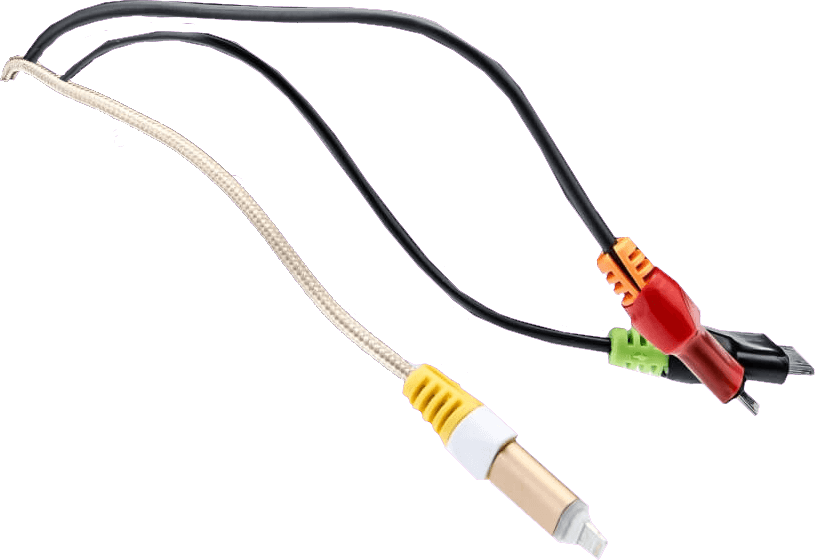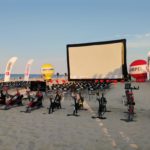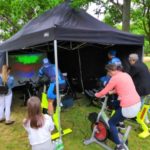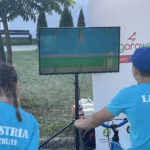How much energy can produce Energybike? What is watt and watthour?
Watt-hour – is a unit of energy. It is equivalent to the energy consumed by the system with a power of 1 watt, continuously operated for 1 hour.
For the purposes of understanding the possibilities set Energybike you can use the following examples.
The difference between Watts (power unit) and Watt-hour (unit of energy): when during pedaling we produce 1 Watt of power, and we will be pedaling for an hour, we will generate 1 Watt-hour of energy. If we produce 100 Watts of power, after one hour we will generate 100 Watt-hours.
An adult can produce from 40 to 350 Watts, depending on the strength and fitness. The power produced by an average user usually ranges between 50 to 200 Watts. Let’s suppose that you generate 100 Watts while pedaling. In practice, this means that you would be able to power on a regular basis, while pedaling, eg. small 100 Watts tv receiver. The electric device would work only during cycling. After the cessation of pedaling power supply would be interrupted. Set Energybike can store the power in the battery (power station). Then, after two hours of cycling with instantaneous power output of 200 Watts we will be able to store 200 Watt-hours of energy (100 Watts x 2 hours = 200 Wh).
How much energy produces the average user? What effort is required?
In answer to your question how much energy an average user is able to produce, we give you some examples. Please bear in mind that efficiency of spinning bike is higher than of the traditional one.
– riding with high resistance like riding up the hill with a moderate pace, can power the 120-watt low speed juicer and it takes about a minute to produce a glass of beverage;
– cycling on low resistance like riding up the gentle slope with a moderate pace, can produce between 50 and 100 watts. In practice, this means that you can power the 50-100 watts unit for example a medium-sized receiver tv or our music sound system (see „Shows and events”);
– free riding without any resistance can fund all small devices up to 50 watts: phone chargers, fans, chains and LED lighting;
Ways to use energy
The energy produced while riding the Energybike can be used in 3 ways:
Consumed on the fly
Energy can be consumed on the fly, without storing it in the battery – when someone is riding the Enrgybike the connected device works. When someone stops pedaling – the device stops working. For this purpose we have created a device named „station of processing power” – a small box about the size of an A4 sheet and weighing about 3 kg. The station is equipped with 3 types of sockets: the power devices AC 230V AC (direct current as in normal domestic socket), DC 12V DC (such as a cigarette lighter socket) and current 5V DC (USB). This solution can be used to power a relatively small electrical devices: eg. phone chargers, all kinds of lighting, fan, radio, MP3 player, speaker, TV, blender, low speed juicer juice – generally speaking one Energybike can power any device with power to approx. 150 watts. You can connect the power generated by several Energybikes and directly power the 1000 watts unit – for this purpose there is a separate module called totalizer.
Accumulated in a power station and used after the completion of training
Energy can be stored in the portable power station and afterwards used to power devices. The result is that the device connected to a power station works regardless of whether someone is pedaling on Energybike or not (of course, until the discharge of the battery). Energy Station is equipped with a special battery charging system, inverter that converts the DC voltage of the battery 12V DC to AC 230 AC (such as in a home outlet), the cigarette lighter socket 12V DC socket and USB aesthetic and durable housing. This solution has the advantage that the power station can store energy for a long time without wear of the automatically and thus feed devices with greater power. This solution is furthermore very flexible – you can choose the parameters of the individual components to meet your needs – battery with a capacity of 20 Ah to 300 Ah and even more, converters with power ratings from 200 W to 2000 W, and therefore, the ability to connect more Enrgybikes to one station , different types of casing- manual, on wheels, transparent, etc.
Transmitted on the fly to the electrical system of the building by means of an inverter network
Energy can be transferred directly to the electrical system in the building and thereby reduce power consumption. For this purpose, a device called an inverter network – connected directly to an ordinary 230V AC outlet in the wall and you cantransfe current from Energybike directly to the network budynku. Inwerter network is a very advanced device that synchronizes with the mains voltage, it is protected insular and overcurrent. The advantage of this solution is the relatively low cost (about 800 zł net for 1 inverter power up to 300 watts), simplicity, low weight and elegance. You can of course be connected in this way more Energybike in one location, eg. Health club.
Stationary indoor bike trainer
Spinning bicycle
The regulator and generator
The regulator- a device that protects the battery against accidental deep discharge and overcharging. In short, thanks to this device, we are confident that produced current will safely and efficiently charge the battery. Additionally it guarantees protection from back-up power to the generator.
A generator – a device that converts mechanical energy of rotation to the electricity current. In short, it is thanks to the generator that electricity is produced when we’re riding the bike.
The energy station
Energy station is nothing but a battery equipped with a special charging system, inverter that converts the DC voltage of the battery 12V DC to AC 230 AC (such as in a home outlet), the cigarette lighter socket 12V DC socket and USB aesthetic and durable housing.
This solution has the advantage that the power station can store energy for a long time without wear of the automatically and thus feed devices with greater power.
This solution is furthermore very flexible – you can choose the parameters of the individual components to meet your needs – battery with a capacity of 20 Ah to 300 Ah and even more, converters with power ratings from 200 W to 2000 W and more, the ability to connect more Energybikes to one station , different types of housing – manual, on wheels, transparent, etc. the battery mounted in the base of the portable power station has a capacity of 20Ah and 12V. This gives us about 240 watt-hours. Fully charge the mobile power station using Energybike by the average adult takes a total of approx. 3 hours. You do not need to charge to the end of a time – can easily be recharged in your free time.
Processing station voltages
It is a small box about the size of an A4 sheet and weighing about 3 kg. The station is equipped with 3 types of sockets: the power devices AC 230V AC (direct current as in normal domestic socket), DC 12V DC (such as a cigarette lighter socket) and current 5V DC (USB).
This solution can be used to power a relatively small electrical devices: eg. Phone chargers, all kinds of lighting, fan, radio, MP3 player, speaker, TV, blender, low speed juicer juice – generally speaking one bike can power any device with power to approx. 150 watts.
Power combiner
Inverter network
Inverter network is a very advanced device that synchronizes with the mains voltage is protected island and overcurrent.
The advantage of this solution is the relatively low cost (about 800 zł net for 1 inverter power up to 300 watts), simplicity, low weight and elegance. You can of course be connected in this way more Energybikes in one location – eg. Health club.
Part model has a built-in rectifier bridge and the discharge resistor so that the voltage of the generator is always in the range of the rated voltage of the inverter. Additionally, it has over-voltage protection, which is activated in the event of exceptionally high input voltage so that the device is extremely safe.
On the rear panel are 4 connectors – black and white to connect the generator, and 2 black to connect the discharge resistor.
Above there are 4 LEDs, 3 green and 1 red. 3 green LEDs start to light in sequence from left to right, when a voltage from the network on one side and the voltage generator of the other. Sequential lighting 3 green LED indicates the correct operation of the inverter. Tempo lighting diodes shows the amount of power transmitted from the generator to the electrical network in the building. The more power the faster pace of lighting diodes.
If not detected AC voltage in the socket red LED lights and the inverter does not provide power to the system – this is the so-called „safety island” (island protection) – for this to eg. During a power cut to your home does not strike bystanders it repairers .
LCD display
On the front panel of the inverter is a small LCD screen and output power cord that plugs into the socket in the building. The screen displays the following parameters: voltage network in the building, the current into the grid, active power and total energy.
Features:
The measurement of electrical parameters (voltage, current, active power and energy)
The time measurement operation (record total number of hours of work)
The backlight.
The write data when switched off (recording kWh and time)
staff
UP button – a short press causes the display of power, energy, current and voltage on
DOWN button – a short press causes the display of power, energy, current and voltage in order.
BACK LIGHT – short press activates the backlight.
Model
500
Rated AC output power
450W
The maximum AC output power
500W
Output voltage range AC
210-240 V
The frequency range of output voltage AC
46Hz ~ 65Hz
Total Harmonic Distortion (THD)
<5%
power factor
0.99
Input voltage range DC
(Measuring point at the output of the rectifier)
10.8-30V
.
Maximum efficiency inverter
92%
Power consumption in idle mode
<1.5W
The shape of the output voltage
Pure sine wave (Pure Sine-wave)
MPPT
Yes
overcurrent protection
Yes
Protection against overheating
Yes
Reverse polarity protection
Yes
securing island
Yes
Parallel connection
Yes







